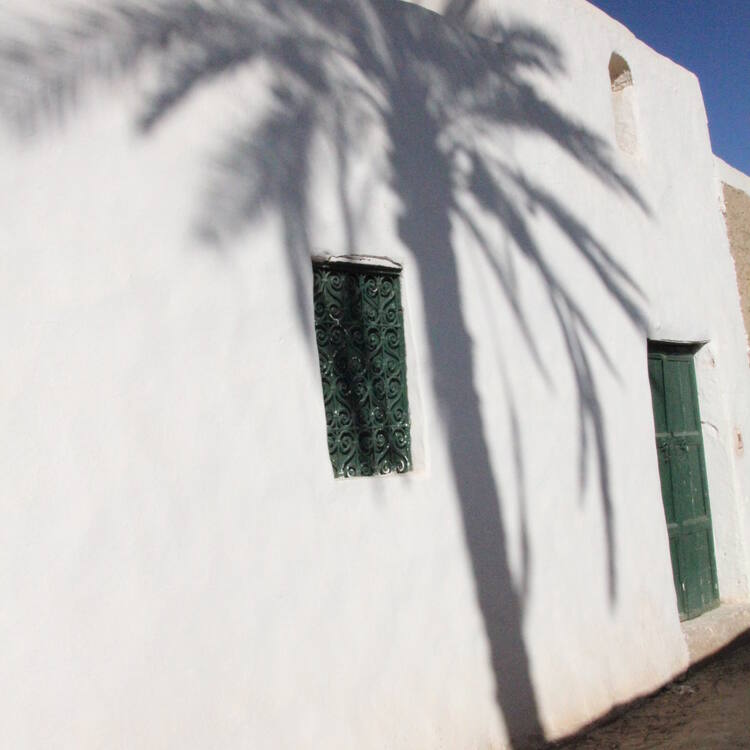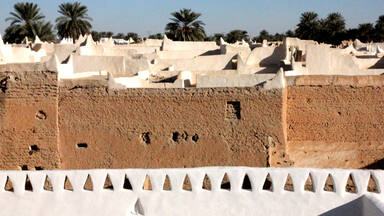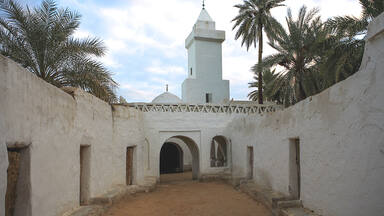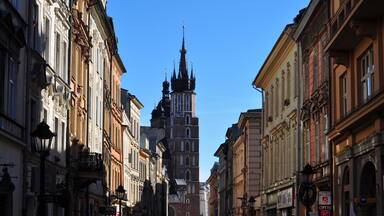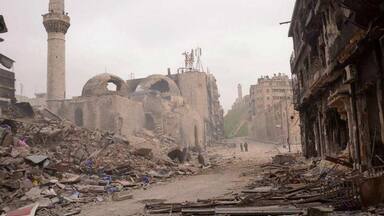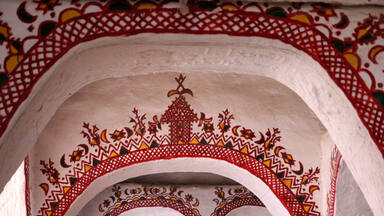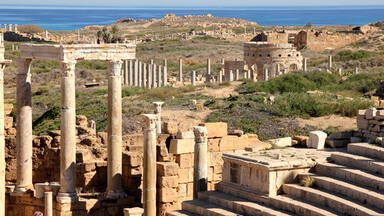Old Town of Ghadamès
Old Town of Ghadamès
Ghadamès, known as 'the pearl of the desert', stands in an oasis. It is one of the oldest pre-Saharan cities and an outstanding example of a traditional settlement. Its domestic architecture is characterized by a vertical division of functions: the ground floor used to store supplies; then another floor for the family, overhanging covered alleys that create what is almost an underground network of passageways; and, at the top, open-air terraces reserved for the women.
Description is available under license CC-BY-SA IGO 3.0
Ancienne ville de Ghadamès
Bâtie dans une oasis, Ghadamès, « la perle du désert », est une des plus anciennes cités présahariennes et un exemple exceptionnel d'habitat traditionnel. Son architecture domestique se caractérise par les différentes fonctions assignées à chaque niveau : rez-de-chaussée servant de réserve à provisions, étage familial surplombant des passages couverts aveugles qui permettent une circulation presque souterraine dans la ville et terrasses à ciel ouvert réservées aux femmes.
Description is available under license CC-BY-SA IGO 3.0
مدينة غدامس القديمة
بنيت غدامس في واحة وسميت "لؤلؤة الصحراء" وهي إحدى أقدم المدن التي قامت في حقبة ما قبل الصحراء وخير مثال على الموئل التقليدي. وتتميز هندستها المنزلية بتوزيعها الوظائف المختلفة على مختلف الطبقات: الطبقة الأرضية لتخزين المؤونة، والطبقة العائلية تشرف على ممرات مسقوفة مموهة تسمح بتنقل تحت الأرض تقريبًا في المدينة وشرفات مكشوفة مخصصة للنساء.
source: UNESCO/CPE
Description is available under license CC-BY-SA IGO 3.0
加达梅斯古镇
加达梅斯古镇建在沙漠绿洲上,历来以“沙漠之珠”著称,是撒哈拉北部边缘最古老的城市之一,同时也是传统聚集地的典范。那里,家庭建筑的突出特点是每一层都有不同的作用:底层储备给养,在漆黑封闭的过道上面另外突出的一层供家人生活居住,而顶层露天的平台是专为妇女准备的。
source: UNESCO/CPE
Description is available under license CC-BY-SA IGO 3.0
Старый город в Гадамесе
Гадамес - «жемчужина пустыни» - находится в оазисе. Это один из старейших городов на границе Сахары и выдающийся пример традиционного поселения. Его жилая архитектура характерна разделением функций по вертикали: первый этаж используется для складирования запасов, следующий этаж, нависающий над уличными проходами и создающий этим нечто похожее на сеть подземных пешеходных путей – для жизни семьи, наконец, наверху находится открытая терраса, предназначенная для женщин.
source: UNESCO/CPE
Description is available under license CC-BY-SA IGO 3.0
Ciudad vieja de Ghadames
Construida en un oasis, Ghadames, “la perla del desierto”, es una de las más antiguas ciudades presaharianas y constituye un ejemplo notable de asentamiento humano tradicional. El reparto de funciones por planta es característico de su arquitectura doméstica: la planta baja sirve de almacén de provisiones; la planta superior cumple la función de vivienda familiar; y, por último, las terrazas a cielo abierto están reservadas a las mujeres. La planta superior domina una red de pasadizos cubiertos, sin luz, que permiten circular de forma prácticamente subterránea por toda la ciudad.
source: UNESCO/CPE
Description is available under license CC-BY-SA IGO 3.0
ガダーミスの旧市街
source: NFUAJ
Oude stad van Ghadamès
Ghadamès staat bekend als ‘de parel van de woestijn’ en ligt in een oase. Het is een van de oudste pre-Sahara steden en een goed voorbeeld van een traditionele nederzetting. De huiselijke architectuur wordt gekenmerkt door een verticale verdeling van functies: de begane grond wordt gebruikt om voorraden op te slaan, de volgende verdieping is bestemd voor de familie en bestaat uit overhangende, overdekte steegjes die een bijna ondergronds netwerk van gangen vormen. De derde verdieping – het dak – bestaat uit terrassen in de open lucht voor de vrouwen. Tegenwoordig is Ghadamès een kleine oasestad die naast een palmentuin ligt.
Source: unesco.nl
Outstanding Universal Value
Brief synthesis
The Old Town of Ghadamès is an exceptional example of desert urban settlement and architecture demonstrating the extraordinary human response to living in an incredibly harsh environment. Located in the pre-Sahara between the Great Erg sand sea and the Al Hamada el-Hamra stone plateau, the settlement is constructed around the Ain al-Faras spring (locally called ghusuf). The old town’s circular shape, the layout of its built fabric, and the design of its buildings have been determined by climatic conditions and by the management of its water, and are interwoven with the surrounding palm groves. The urban ensemble is protected by the reinforced outer walls of the houses. These features together mitigate the impact of the arid climate and meet the particular socio-cultural needs of the inhabitants.
Ghadamès is one of the oldest and most celebrated Saharan cities, called the ‘Pearl of the Desert’, (Jawhart Al-Sahra) by Arab sources. It has played a key role in the cultural and economic life of the region as an important and peaceful hub for caravan trade as part of the trans-Saharan network. From at least the late first millennium BCE it was occupied by indigenous peoples, called the Phazanii, and has been a point of interchange between major cultures and religions from the Garamantes and Romans who called it Cydamae, the Byzantines, Christianity, the Islamic conquest, Ottoman control, visits by European explorers in the 19th century and subsequent interventions during the colonial period and WWII. Throughout, it has maintained its own particular customs and practices.
Around Old Town of Ghadamès, archaeological remains in stone, including Roman- period defences and the largest mausolea in the region, attest to the importance, wealth and status of the early occupants. Meanwhile, within the property, the surprising urban structure, and the medieval traditions of mud architecture and handicrafts survive intact to the present day. The outstanding system of dwellings, mostly built over two storeys, give privacy and movement to women via the terraces above them, while public mostly covered spaces below afford meeting places for men and children. The city’s history and society have been shaped by the environment and the harmony between them remains central to its unique character and continuous survival. The complex balance between natural, urban and architectural features within this ecological system makes the settlement increasingly vulnerable to changes to the water supply, humidity, temperature, agriculture, built environment and population size.
Criterion (v): Ghadamès is an outstanding settlement in the Saharan pre-desert renowned for its exceptional built heritage, erected thanks to long-lasting traditional practices resulting from the particular demands of the harsh climate. For at least 2,000 years, the city has played an important role in the trans-Saharan trade network. It has been a crossroads for the major cultures of the African continent and the Mediterranean basin, while also developing its own unique architecture and traditions related to its historic origins and subsequent interactions. The dwellings are outstanding in their design, combining form and function to create comfortable living spaces which allow gender segregation and privacy as well as communication beyond the household, in addition to protection from the desert winds and the thermal fluctuations typical of the desert climate. The balance between the inhabitants and the environment has been fundamental to the development of the city’s unique urban character, but is also an important factor in its vulnerability to human and climatic change.
Integrity
The city has been continuously inhabited attesting to its long historical integrity. A balanced environmental system has been maintained between the built fabric, water system and palm groves. The significant architectural structures and attributes, as well as the original urban layout, have been retained. Alongside important archaeological remains, it’s historical, cultural, architectural, and functional integrity survives to date. The water system has been restored over time but still functions and continues to be managed by the local community following a unique social system recorded in manuscripts. The necessary balance within the urban organisation as a whole makes the settlement vulnerable to human and climatic change, and requires regular maintenance.
The architectural nature of the settlement, including its streets, public squares, mosques, open spaces and orchards, remains the same, even the parts of the outer wall circuit which have been restored. The architectural elements, such as openings, gates, and entrances, are often decorated with unique motifs and fittings. The building materials are recycled, facilitating maintenance and restoration. The integrity of the intangible attributes associated with the city’s traditional crafts and cultural practices has been maintained by conserving the original construction system unique to the urban settlement: stone foundations for mud brick walls, woodwork, masonry and palm wood casings. The liming of the walls inside and across large outdoor spaces brightens them and highlights the distinctive and intricate, incised and painted decorative patterns. Despite recent impacts from a fire event and heavy rains, altogether the outstanding attributes of this settlement retain sufficient integrity.
Authenticity
The Old Town of Ghadamès has maintained a high level of authenticity by not making changes to the design, materials and workmanship of its buildings, and preserving the balanced environmental system. This results from an awareness of the Ghadamès community of the urban and architectural value of the city and the importance of the continuity of its cultural traditions, which continues to influence the design of modern housing outside of the historic city. The settlement’s originality lies in its attributes which preserve the Outstanding Universal Value in terms of space and setting, form and design, material and essence, use and function, craft traditions and techniques, language and other forms of intangible heritage. Although no resident dwells permanently in the Old Town of Ghadamès, the city’s inhabitants continue to gather and use the houses and spaces of the old town.
The historic fabric retains its form shaped by the combination of unique architectural structures, which consist of compact domestic roofs with high parapets, and covered streets and alleys, both with regular roof openings (tinawt / klava), creating an upper level of terraces reserved for women and children. The use of traditional construction techniques (mud bricks, palm trunks and other traditional building materials) continues in present-day maintenance thereby preserving historic methods and the form and function of the fabric. Local intangible attributes are manifested in cultural practices, traditional construction techniques of mud brick, the water management system following a socially-led organisation of the neighbourhoods, and a strong sense of place and identity. These have been retained throughout the evolution of the city as a sub-Saharan crossroads during Roman, Byzantine, early Islamic and Ottoman periods through to colonial times and its current status as a modern city in the Libyan Desert. An invaluable manuscript tradition represents a precious source of information and attests to Ghadamès’ history and management.
Protection and management requirements
Measures to protect and manage the Old Town of Ghadamès have been established and are being implemented. To guarantee effective protection, the immediate and wider setting needs to be understood and protected.
The old town, including all of its individual monuments, archaeological sites, and natural and cultural heritage, is legally protected and assured by the community of Ghadamès through the provisions of Law No. 3/1994 and its Executive regulations/1995 issued by the General People’s Congress. Effective protection is guaranteed through collaboration between the local authority, the development partners and the Department of Antiquities, the Urban Planning Department, local City Council, civil society associations and the Tourist Police, and the Committee for Management, Implementation of the Conservation and preservation strategy of the five Libyan World Heritage properties. Since 2000, international collaborations and local coordination committees have been established to maintain and conserve the historic fabric.
This management system is reinforced by a ten-year management plan, which caters to several key issues in relation to the property including the safeguarding of traditional construction techniques and the potential impact of climate change. Proactive and planned maintenance of the historic water system was initiated in 2008 and is crucial to sustain the Outstanding Universal Value. Natural and human-driven risks include heavy rains and fire: these require management through ad-hoc risk-management and prevention systems.
